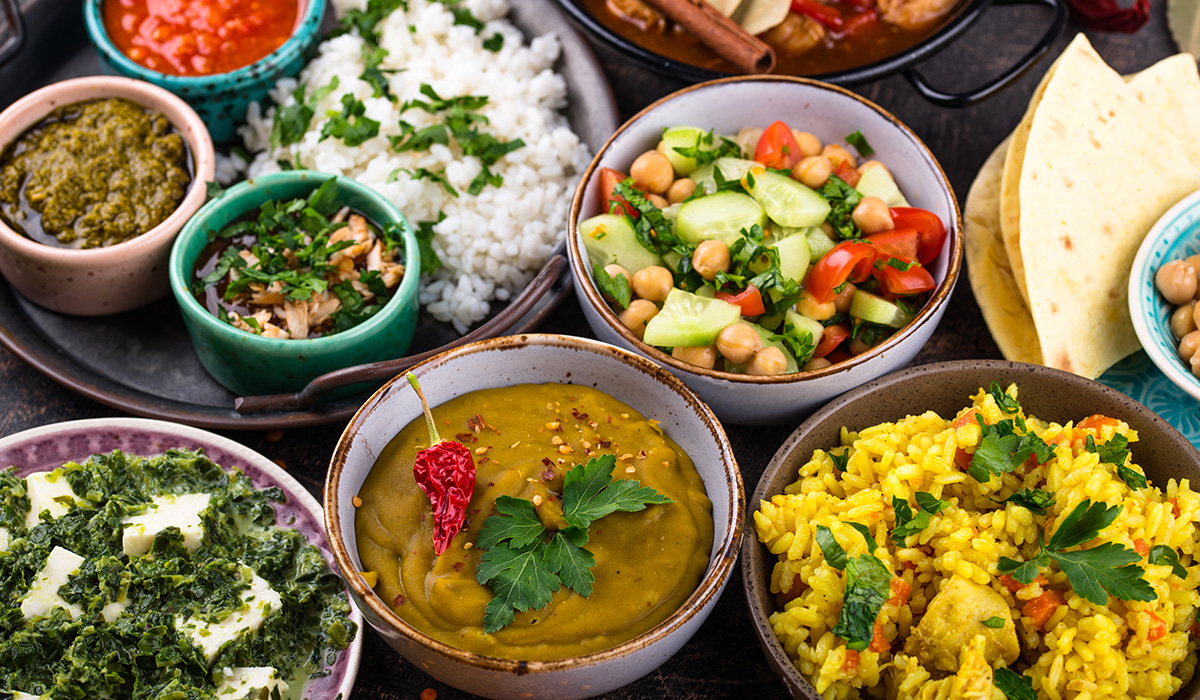Indian cuisine is known for its vibrant spices, fresh herbs, and wide variety of rich flavours. Though diets and preferences vary throughout India, most people follow a primarily plant-based diet. Around 80% of the Indian population practices Hinduism, a religion that promotes a vegetarian or lacto-vegetarian diet.
The traditional Indian diet emphasizes a high intake of plant foods like vegetables, lentils, and fruits, as well as a low consumption of meat.
However, obesity is a rising issue in the Indian population. With the growing availability of processed foods, India has seen a surge in obesity and obesity-related chronic diseases like heart disease and diabetes.
WHY EAT A PLANT-BASED INDIAN DIET?
Plant-based diets have been associated with many health benefits, including a lower risk of heart disease, diabetes, and certain cancers such as breast and colon cancer.
Additionally, the Indian diet has been linked to a reduced risk of Alzheimer’s disease. Researchers believe this is due to the low consumption of meat and emphasis on vegetables and fruits. Following a healthy plant-based Indian diet may not only help decrease the risk of chronic disease, but it can also encourage weight loss.
WHAT FOOD GROUPS DOES IT INCLUDE?
The Indian diet is rich in nutritious foods like grains, lentils, healthy fats, vegetables, dairy, and fruits.
The diets of most Indian people are heavily influenced by religion, particularly Hinduism. The Hindu religion teaches nonviolence and that all living things should be valued equally.
That’s why a lacto-vegetarian diet is encouraged, and eating meat, poultry, fish, and eggs is discouraged. Lacto-vegetarians do, however, eat dairy products.
A healthy lacto-vegetarian diet should focus on grains, lentils, dairy, vegetables, fruits, and healthy fats like coconut oil.
Spices such as turmeric, fenugreek, coriander, ginger, and cumin are at the forefront of traditional dishes, adding rich flavour and powerful nutritional benefits.
Turmeric, one of the most popular spices used in India, is celebrated for its anti-inflammatory, antibacterial and anticancer properties.
A compound in turmeric called curcumin has been found to fight inflammation in the body, improve brain function and reduce risk factors of heart disease.
HEALTHY FOODS TO EAT
There are many delicious foods and beverages to choose from when following a lacto-vegetarian diet for weight loss.
WHAT TO EAT
Try incorporating
- VEGETABLES: Tomatoes, spinach, eggplant, mustard greens, okra, onions, bitter melon, cauliflower, mushrooms, cabbage and more.
- FRUITS: Including mango, papaya, pomegranate, guava, oranges, tamarind, lychee, apples, melon, pears, plums, bananas.
- NUTS AND SEEDS: Cashews, almonds, peanuts, pistachios, pumpkin seeds, sesame seeds, watermelon seeds and more.
- LEGUMES: Mung beans, black-eyed peas, kidney beans, lentils, pulses, and chickpeas.
- ROOTS AND TUBERS: Potatoes, carrots, sweet potatoes, turnips, yams.
- WHOLE GRAINS: Brown rice, basmati rice, millet, buckwheat, quinoa, barley, corn, whole-grain bread, amaranth, sorghum.
- DAIRY: Cheese, yogurt, milk, kefir, ghee.
- HERBS AND SPICES: Garlic, ginger, cardamom, cumin, coriander, garam masala, paprika, turmeric, black pepper, fenugreek, basil and more.
- HEALTHY FATS: Coconut milk, full-fat dairy, avocado, coconut oil, mustard oil, olive oil, peanut oil, sesame oil, ghee.
- PROTEIN SOURCES: Tofu, legumes, dairy, nuts, and seeds.
Meals and snacks should focus on fresh, whole foods flavoured with herbs and spices.
Additionally, adding non-starchy vegetables like greens, eggplants or tomatoes to your meals will provide a boost of fibre that can help you feel satisfied for a longer period after eating.
WHAT TO DRINK
An easy way to cut back on excess calories and sugar is to avoid sugar-sweetened beverages and juices. These drinks can be high in both calories and sugar, which can negatively affect weight loss. Healthy beverage options include:
- Water.
- Sparkling water.
- Unsweetened
UNHEALTHY FOODS TO AVOID
Choosing foods and beverages that are highly processed, loaded with sugar or high in calories can sabotage your weight loss efforts.
Not only are items like sweets, fried foods, and fizzy drinks not good for weight loss — they aren’t good for overall health.
Eating too much processed food and products laden with sweeteners can increase the risk of chronic diseases.
For example, drinking sugar-sweetened beverages like fizzy drinks, fruit punch and juices every day has been associated with increased risks of diabetes, obesity, and heart disease. Plus, consuming unhealthy foods can make it harder for you to lose fat and maintain a healthy weight.
For optimal health, minimize the following foods or avoid them altogether:
- SWEETENED BEVERAGES: Fizzy drinks, fruit juice, sweetened tea, sweet lassi, sports drinks.
- HIGH-SUGAR FOODS: Sweets, ice cream, cookies, rice pudding, pastries, cakes, sweetened yogurt, high-sugar cereals, digestive biscuits.
- SWEETENERS: Jaggery, sugar, honey, condensed milk.
- SWEETENED SAUCES: Salad dressings with added sugar, ketchup, barbecue sauce, sweetened curries.
- HIGH-FAT FOODS: Fast food like McDonald’s, French fries / chips, crisps, fried foods, bhujia.
- REFINED GRAINS: Products including white bread, white pasta, biscuits.
- TRANS FATS: Margarine, vanaspati, fast food, highly processed foods.
- REFINED OILS: Canola oil, soybean oil, corn oil, grapeseed oil.
Although it’s perfectly fine to enjoy an occasional treat, limiting the foods and beverages listed above is best for overall health.
A HEALTHY INDIAN SAMPLE MENU FOR ONE WEEK
Below is a healthy one-week Indian sample menu that focuses on fresh, nutritious food. You can adjust it according to your calorie needs, dietary restrictions, and food preferences.
MONDAY
BREAKFAST: Sambar with brown rice idli.
LUNCH: Whole-grain roti with mixed-vegetable curry.
DINNER: Tofu curry with mixed vegetables and a fresh spinach salad.
TUESDAY
BREAKFAST: Chana dal pancakes with mixed vegetables and a glass of milk.
LUNCH: Chickpea curry with brown rice.
DINNER: Khichdi with sprout salad.
WEDNESDAY
BREAKFAST: Apple cinnamon porridge made with milk and topped with sliced almonds.
LUNCH: Whole-grain roti with tofu and mixed vegetables.
DINNER: Palak paneer with brown rice and vegetables.
THURSDAY
BREAKFAST: Yogurt with sliced fruits and sunflower seeds.
LUNCH: Whole-grain roti with vegetable subji.
DINNER: Chana masala with basmati rice and green salad.
FRIDAY
BREAKFAST: Vegetable dalia and a glass of milk.
LUNCH: Vegetable sambar with brown rice.
DINNER: Tofu curry with potato and mixed vegetables.
SATURDAY
BREAKFAST: Multigrain parathas with avocado and sliced papaya.
LUNCH: Large salad with rajma curry and quinoa.
DINNER: Lentil pancakes with tofu tikka masala.
SUNDAY
BREAKFAST: Buckwheat porridge with sliced mango.
LUNCH: Vegetable soup with whole-grain roti.
DINNER: Masala-baked tofu with vegetable curry.
Drinking water, seltzer, or unsweetened tea with and between meals will keep you hydrated without adding extra calories. Make sure to consume plenty of non-starchy vegetables at every meal, as well as sources of healthy fat and protein. This will keep you feeling full throughout the day and reduce the chances of overeating.
HEALTHY SNACK OPTIONS
Replacing high-calorie, sugary snacks with healthier options can promote weight loss and help keep you on track towards your weight loss goals. Like meals, nutritious snacks should revolve around fresh, whole ingredients. Here are some weight loss friendly snack ideas:
- Small handful of nuts.
- Sliced fruit with unsweetened yogurt.
- Vegetable chaat.
- Sprout salad.
- Roasted pumpkin seeds.
- Sliced fruit with nuts or nut butter.
- Roasted chickpeas (channa).
- Hummus with vegetables.
- Bean salad.
- Salted popcorn.
- Unsweetened kefir.
- Homemade trail mix.
- Fennel seeds.
- Fresh fruit with cheese.
- Broth-based vegetable soup.
If you are craving a sweet snack to have with evening tea, swapping out your usual dessert for fresh, sliced fruit might do the trick. For another healthy dessert option, top unsweetened yogurt with cooked fruit and crunchy nuts for a satisfying combination.
THE BOTTOM LINE
Following a lacto-vegetarian Indian diet is a great way to lose weight. It will help you cut back on sugary foods and beverages, eat more vegetables, and increase your protein intake.
Add regular exercise to your regimen to boost your health and weight loss even more.


